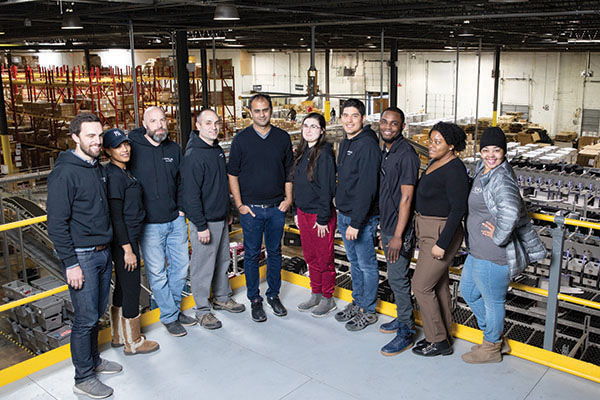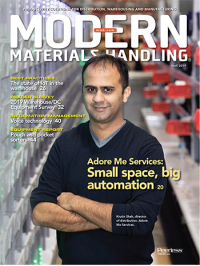Adore Me Services: Small space, big automation
Adore Me Services packs a lot of automation power into a relatively small space to deliver the right customer experience.
Anyone who has watched “Tiny House Hunters” knows that going small is one of the hottest trends in the real estate market. Whether it’s baby boomers downsizing for retirement or young couples simplifying their lives, people are foregoing McMansions for spaces not much bigger than a New York City studio apartment. But that doesn’t mean they’re giving up on McMansion amenities: These little places can be chock full of granite, tile and hardwood.
A similar trend is taking place in the distribution market, especially around e-fulfillment. While the typical DC featured in Modern Materials Handling is 500,000 square feet or more, retailers and e-tailers are looking at smaller footprints to get nearer to their customers. But, like tricked out tiny houses, that doesn’t mean they’re giving up on automation. The truth is, regardless of the size of the space or company, e-commerce fulfillment operates at a different pace than store replenishment. Even a small, fast-growing e-tailer has to design processes and systems that meet today’s customer service level expectations if it’s going to do its own distribution.
Case in point: Adore Me Services, the Secaucus, N.J.,-based distribution arm of Adore Me, a fast-growing e-commerce retailer selling women’s lingerie, sleepwear, swimwear and activewear. In 2017, the then five-year-old startup set out to build its first distribution center to control the customer experience. The result was a 130,000-square-foot facility across the Hudson River from the company’s New York headquarters that packs a lot of order fulfillment automation in a comparatively small space.
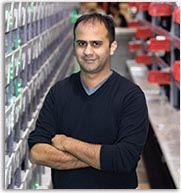 “We wanted to be as close to New York as possible, but in a footprint we could afford and with a system that could support at least three year’s growth out of the facility,” says Krutin Shah, director of distribution. “That’s where automation came into play.”
“We wanted to be as close to New York as possible, but in a footprint we could afford and with a system that could support at least three year’s growth out of the facility,” says Krutin Shah, director of distribution. “That’s where automation came into play.”
The solution designed by the system integrator (Bastian Solutions) fits a high-density robotic storage and order picking system (AutoStore), two automated putwalls (OPEX Sure Sort) that can handle about 80% of the facility’s SKUs, a conventional putwall for the remaining 20% of SKUs, and conveyor and sortation into an area about 35,000 square feet in size. The rest of the facility is dedicated to receiving, reserve storage, packing and shipping, plus one aisle of flow rack for the 200 fastest-moving SKUs. That area is directed by pick-to-light and totes coming from that area are directed to one of the automated putwalls, the conventional putwall or a single line packing area.
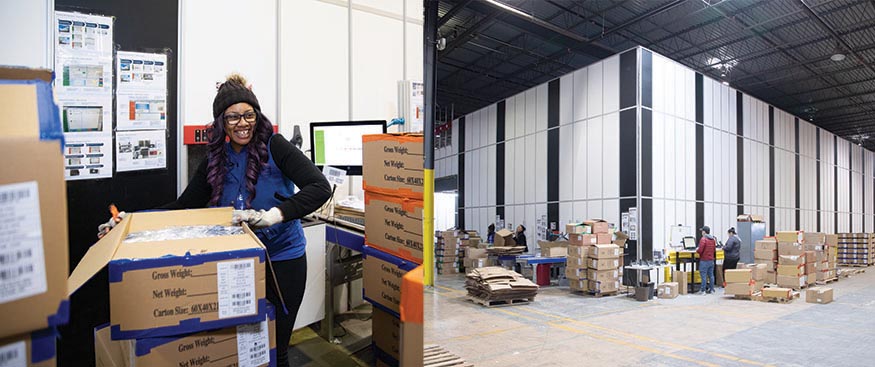
Merchandise is inspected and prepared for storage in receiving (left) and then sent to the AutoStore for replenishment (right).
While it may be relatively small, the system manages about 25,000 SKUs with the addition of 500 to 800 new SKUs a month and fills an average of 5,000 to 7,000 orders per day. With some 400 cubby locations each, the automated putwalls can sort up to 2,400 units per hour compared to about 300 units per hour in a conventional putwall.
The order fulfillment solution was designed to grow with Adore Me in two ways; the organization can add shifts and, when that is maxed out, there is room to add to the automation. More importantly, the new facility allowed Adore Me to up its customer service game. “We’re now able to handle our demand and provide the customer experience that was designed by our marketing teams,” Shah says.
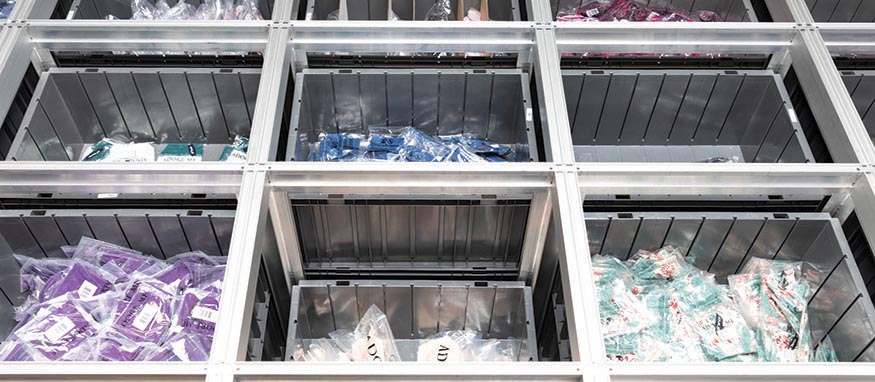
Totes are delivered to a goods-to-person pick station (top).
Growing pains
Ranked No. 36 on Crain’s 2018 Fast 50 list of fastest-growing companies in New York City, Adore Me was founded about seven years ago to take on the likes of Victoria’s Secret by a Harvard Business School MBA student. The company has a customer base of more than 11 million women, predominately urban millennials, with 80% of its traffic coming from mobile devices. While it began as an e-tailer, Adore Me has added special services, like an Elite program that ships a selection of three to five items each month to participants based on their preferences, and opened two retail locations in 2018 with plans to open more in 2019. In 2017, the last year for which sales revenues were available, Adore Me touched $100 million in revenue.
Like many start-ups, order fulfillment was initially outsourced to a third-party logistics (3PL) provider. When the company outgrew the first 3PL’s capacity, it went with a larger provider. By the end of 2016, it had outgrown capacity there as well. “When we left our first 3PL, we were occupying two aisles of their facility,” Shah says. “When we left the second, we were occupying 10 to 12 aisles. We had also added to our product line, which added complexity, and we were shipping to Canada, Australia and the UK.”
More importantly, he adds, the company’s vision was expanding. In the early days of the start-up, the focus was on acquiring new customers. As the business matured, the focus shifted to customer retention through a superior customer experience. New offerings and retail stores were on the drawing board. More emphasis was placed on packaging and presentation. All of those tweaks to the business model would have an impact on distribution operations. “As our business model evolved, we needed distribution that was flexible,” says Shah. “We didn’t want to adapt the business timeline to a distribution timeline.”
Things came to a head on Valentine’s Day 2017, Adore Me’s peak holiday. “Some customers who placed orders up to 10 days before Valentine’s Day didn’t receive them until after Valentine’s Day,” Shah recalls. Soon after, one of the co-founders suggested to the board that it was time for the company to build its own distribution center. “The idea was that if we control our supply chain, we can control the customer experience, and we can control our own destiny,” Shah says. A month later, the team got the go ahead to build a new DC and a new distribution team (see box, below).
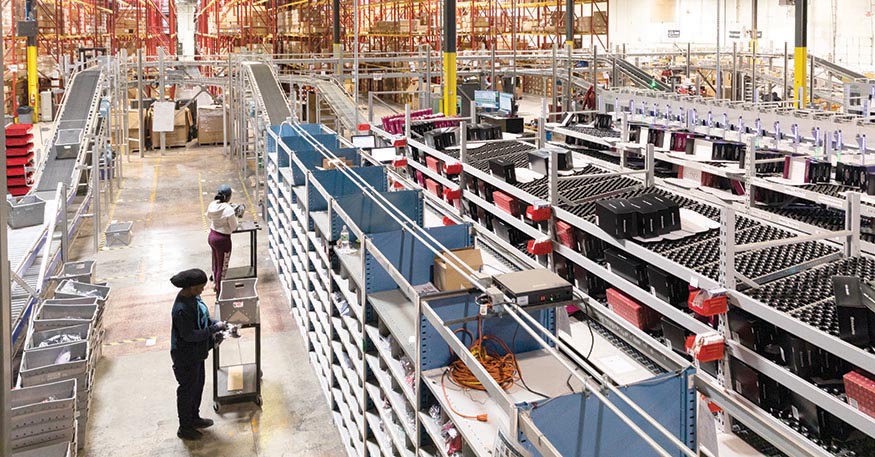
In addition to the automated putwall, Adore Me Services also uses conventional putwalls for order consolidation.
Design from the ground up
Building a greenfield facility gave the Adore Me Services team the chance to design a solution without pre-conceived notions or existing systems. The project, which kicked off in June 2017, unfolded with four big steps.
The first was site selection: The facility needed to be near the company’s New York City headquarters. That led to the New Jersey location across the Hudson River. The second was the selection of a warehouse management system (WMS) that was right for the operation and integration with the company Website. The third was the selection of an integrator with the best design to meet Adore Me’s needs. Part of that was coming up with a design that could meet Adore Me’s projected needs for at least three years in a compact facility: Getting close to New York City meant that a 300,000-square-foot distribution center was probably out of the question. That meant automation was going to be important. The last was to build a distribution team from scratch.
“When we started this, our co-founders’ strategy was to design a system that would allow us to start with one shift, and then expand over time to two or three shifts,” Shah recalls. “That would allow us to grow in this location.” While automation was going to be expensive up front, done right, it would reduce the cost per order compared to working with a 3PL. “A system was only short-listed if it could meet that criteria,” Shah says.
Ultimately, the best design was a combination of the robotic order picking solution, the automated putwalls and rack storage. What sold the team on that combination? “We looked at a number of proposals and did a number of site visits,” Shah says. “In the end, we have a reasonably large number of SKUs for a facility of this size, plus we’re adding 500 to 800 SKUs a month. We needed dense storage to manage the large number of SKUs, and we needed an efficient way to get at SKUs for our order profile.”
The decision to use an automated putwall was the result of looking at the best way to sort after batch picking. “The traditional way to do that is with a light-directed putwall,” Shah says. “But, most of the packages we handle are small and the average number of items per order is small.” One of the integrators suggested an automated putwall because the technology was originally designed for mail sortation. The manufacturer’s analysis was that 80% of Adore Me’s product could go through that system, with just 20% going to a traditional light-directed putwall. The catch: The OPEX system had never been integrated with an AutoStore system in the past. “Our system integrator was confident they could do the integration,” Shah says. It was a risk, but one they were willing to take.
The reserve storage area is a combination of rack and floor storage. Product that is likely to go soon to the robotic order picking solution is stored on the floor because it’s more efficient to access and ship it from there. Remaining product is stored in pallet rack. There is also one area of flow rack for picking the 200 fastest-moving SKUs.
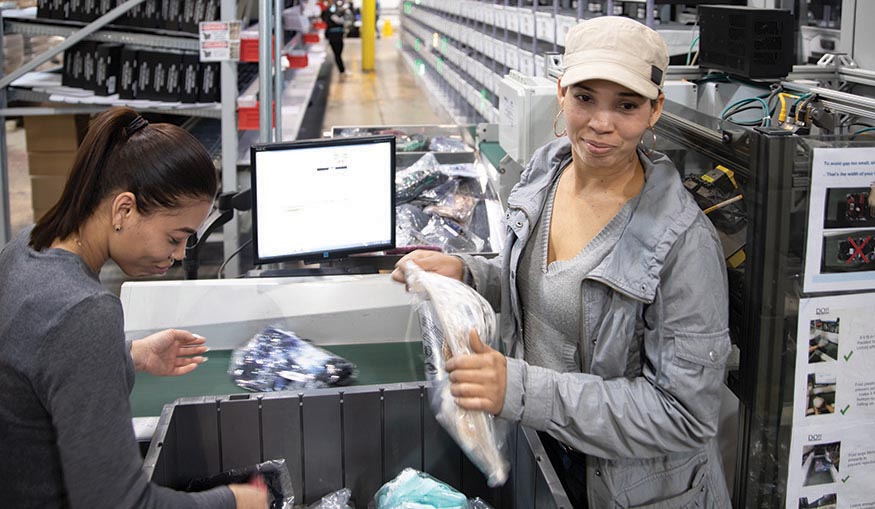
Going live
The project had a very aggressive timeline. From the kickoff in the early summer of 2017, Adore Me Services, the newly created distribution arm, began manual pick, pack and ship operations in October 2017, but with a limited number of orders.
In fact, Adore Me continued to work with a 3PL until the middle of 2018 to provide a seamless customer experience whenever possible. Over the next eight months, the team integrated the WMS with the Website and the warehouse control system and began to build a team of associates. “The original team was me, our co-founder, an ex-Amazon manager and other members of our supply chain team,” Shah recalls. “Then, we brought on a software systems expert, an HR manager, finance and inventory manager and an individual to manage safety and loss prevention.”
With key people in place, Adore Me Services began working with several temp agencies to add associates into the mix a handful at a time. “We were investing in people who would stay with us and had the potential to be trained for the next level when we brought in the automation,” Shah says.
Building distribution expertise
Adore Me Services’ Secaucus distribution center wasn’t just a new facility; it was also a crucial step toward building internal distribution expertise. Going forward, distribution director Krutin Shah believes those capabilities will enable Adore Me to deliver a superior customer experience as it continues to modify its business model. What advice does Shah have for other fast-growing companies looking to do the same?
Ask lots of questions: “When we asked a lot of questions, we discovered that the solution that ultimately worked for us was not what we thought we needed going into the project,” Shah says.
Don’t be afraid of a calculated risk: “The job of most integrators is to play defense, so they all had more risk-averse solutions because that’s what they’re used to providing to customers,” Shah says. “We were willing to take a risk, which is how we ended up with AutoStore and the OPEX Sure Sort, which had never been integrated before.”
Know stuff will happen: We’ve all read the more colorful bumper sticker version of: Stuff Happens. And, according to Shah, “It happened. It took us awhile, for instance, to figure out the best way for the AutoStore and Sure Sort to work together. But, we invested the time and energy to make it work, and it’s paid off.”
Take time to build a culture: Adore Me Services did not flip the switch from 3PL to fulfilling everything from the new DC on day one. Instead, it transitioned slowly over an eight-month period. In the meantime, it built a small management team for the DC; then added a systems expert, HR manager and safety manager; and finally began bringing on temporary associates who might turn into full-time equivalents a handful at a time. By the time they ceased using a 3PL, there was a team of about 80 associates, including maintenance technicians and lift truck drivers who had been trained internally.
“Our premise has been to build a great culture, a great team and help people grow their skills with us,” Shah says. “We have now trained a team that can operate the AutoStore, the Sure Sort or any technology that we choose to put in here.”
By February of 2018, a team of just more than 30 associates was in place; that grew to about 80 over time. Since then, some have transitioned from temp to full-time positions on the floor, while others have been trained to maintain the automation and operate lift trucks.
The automation went live in March of 2018, roughly eight months after the kickoff. Before the summer was out, the 3PL had been phased out. “We could not have been in a better spot,” Shah says. “We had our smoothest holiday season in three years and the fact that we did this all in a very short period of time gave us a boost in confidence.”
The full system, including the automation, has been up and running for nearly a year as of this story. “We’re still learning today,” says Shah. In addition to delivering on Adore Me’s customer experience, flexibility is an important benefit of the system. For example, while the solution was designed for e-commerce order fulfillment, the AutoStore picking technology is now also being used to build mixed item cartons for store replenishment. Once a carton is complete, it’s delivered to a small value-added processing center where store tickets and RFID tags are added to get items store ready. And although returns are negligible now, Adore Me’s subscription service is growing in popularity, which will increase the number of returns that have to be processed in the future. To that end, Shah and his team are investigating ways to use the automation to handle returns.
“When we were with a 3PL, we didn’t always understand how difficult it can be to change the distribution process when we changed the business model. For a company with an evolving business model, we now have a very flexible distribution system that we can use to our advantage in the market

Article Topics
Automation News & Resources
Walmart chooses Swisslog AS/RS and software for third milk processing facility Lucas Watson appointed CSO for Körber’s Parcel Logistics business in North America 60 Seconds with Bob Trebilcock, outgoing executive editor, Modern Materials Handling Kathleen Phelps to join FORTNA as chief financial officer Coles automates grocery distribution in Australia 2024 Intralogistics Robotics Survey: Robot demand surges Warehouse automation extends life of cheese DC by a decade More AutomationLatest in Materials Handling
Registration open for Pack Expo International 2024 Walmart chooses Swisslog AS/RS and software for third milk processing facility NetLogistik partners with Vuzix subsidiary Moviynt to offer mobility solutions for warehouses Materials Handling Robotics: The new world of heterogeneous robotic integration BSLBATT is looking for new distributors and resellers worldwide Lucas Watson appointed CSO for Körber’s Parcel Logistics business in North America Hyster recognizes Dealers of Distinction for 2023 More Materials HandlingAbout the Author
Subscribe to Materials Handling Magazine

Find out what the world's most innovative companies are doing to improve productivity in their plants and distribution centers.
Start your FREE subscription today.
April 2024 Modern Materials Handling

Latest Resources


